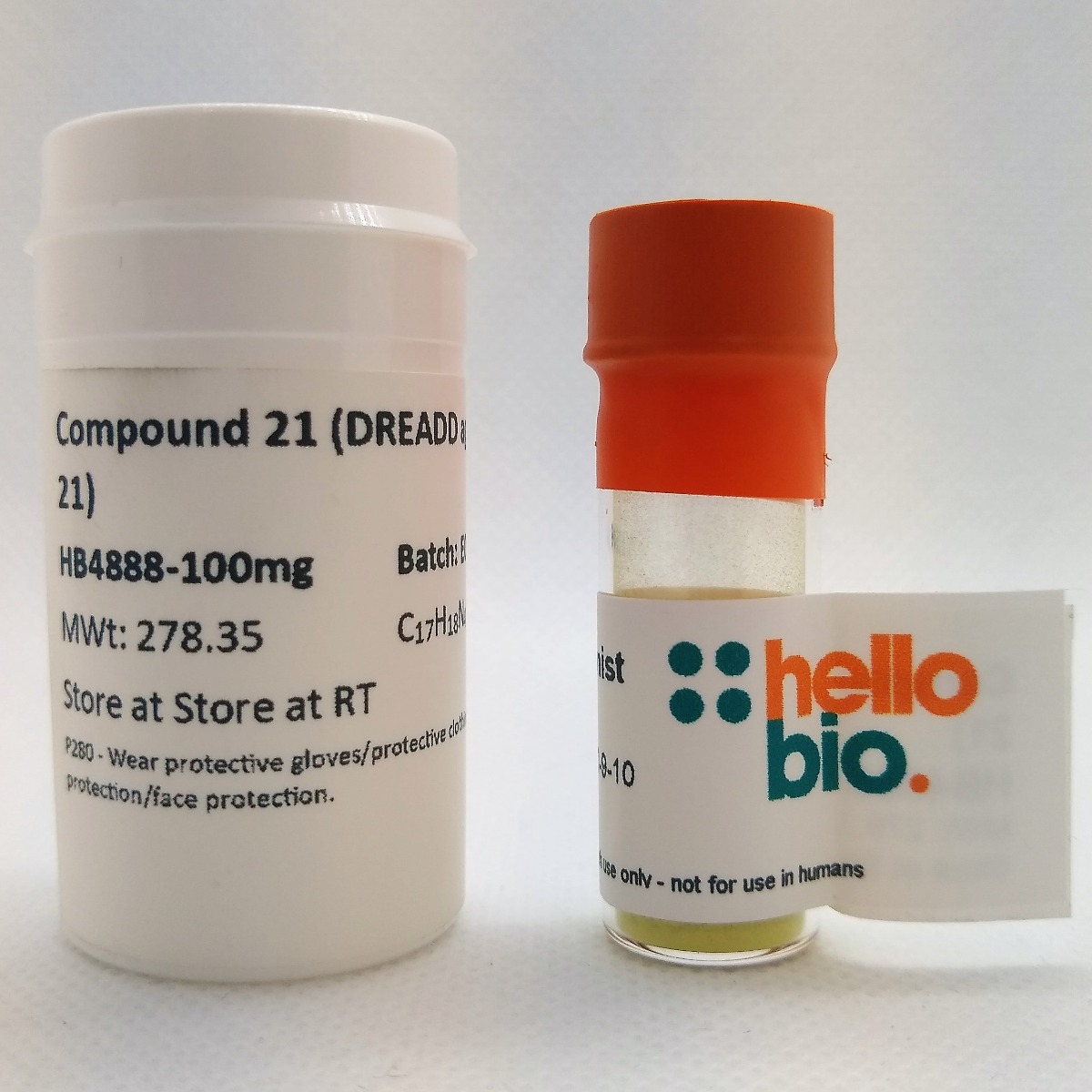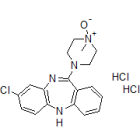| Overview
DREADD agonist 21 (Compound 21) represents an alternative chemogenetic actuator for muscarinic -based DREADDs and an alternative to CNO for in vivo studies in which metabolic conversion of CNO to clozapine is an issue.
DREADD agonist 21 (Compound 21) has excellent bioavailability, pharmacokinetic properties and brain penetrability. It has been reported that the compound does not undergo back metabolism to clozapine.
DREADD agonist 21 is a potent and selective agonist at muscarinic based DREADDs such as the excitatory hM3Dq, hM1Dq and inhibitory hM4Di DREADDs (pEC50 values are 8.48, 8.91 and 7.77 at hM3Dq, hM1Dq and hM4Di respectively). The compound exhibits >10-fold higher affinity at hM1Dq and hM4Di DREADDs compared to wild type receptors and also lacks agonist activity at wild type receptors.
In vivo use
DREADD agonist 21 from Hello Bio has recently been cited in a pharmacokinetic profile of the compound in mice by Jendryka et al (2019) which suggests that DREADD agonist 21 shows superior brain penetration and long-lasting presence. They suggest that the compound is a suitable DREADD agonist (0.4-1 mg/kg) which is effective at latest 15 min after i.p injection, but requires between-subject controls for unspecific effects.

Figure: In vivo pharmacokinetic profile of DREADD agonist 21 (Cmpd-21). DREADD agonist 21 was from Hello Bio.
(j–l): Concentration (nM) of Cmpd-21 (blue) at 15, 30 and 60 min after i.p. injection of 3.0 mg/kg Cmpd-21 in (j) plasma, (k) CSF, and (l) cortical brain tissue. Reproduced from Jendryka et al Sci Rep. 2019;9(1):4522
DREADD agonist 21 (Compound 21)-induced activation of hM3Dq and hM4Di can modulate bi-directional feeding in defined circuits in mice. Concentrations of DREADD agonist 21 that resulted in changes in feeding behavior in animals expressing muscarinic DREADDs had no off-target effects in control animals (where musarinic DREADDs were not expressed).
Bonavenutra (2018) suggest that the compound exhibits lower in vivo DREADD potency than clozapine and is not efficient in nonhuman primate (NH) applications.
Off target binding / effects
Bonavenutra (2018) reported DREADD ligands while efficacious in certain applications may not display sufficient potency or selectivity in others.
DREADD agonist 21 shows weak to moderate binding affinity at a range of wild type GPCRs which may translate to functional antagonism in vivo.
Care should therefore be taken with in vivo dosing of DREADD agonist 21 to ensure the free concentration of the compound remains in a range that activates muscarinic DREADDs but is sufficiently low to avoid antagonism at wild type GPCRs.
Strong competitive binding of DREADD agonist 21 (Cmpd-21) to receptor sites of dopamine, 5-HT, opioid, muscarinic, histamine and adrenoceptors in mice has been shown. Only very subtle, if any behavioural alterations using the 5-CSRTT assessment were found Jendryka et al (2019).
In vivo experiments should be conducted with the appropriate controls where DREADD agonist 21 is administered to animals that do not express the muscarinic-DREADDs.
Bonavenutra (2018) reported that doses higher than 1mg/kg produced off-target effects in mice without DREADDs and that the compound displays off-target effects in monkeys at the minimal hM4Di-effective doses.
Goutaudier (2020) reported off-target effects in the TH-Cre rat model using hM4Di DREADDs (strong increase in nigral neuron activity in control animals at 1mg/kg in males) and a transient and residual off-target effect at 0.5 mg/kg in females). In males, 0.5 mg/kg circumvented this effect to potently activate hM4Di without off-target effects
| ![Compound 21 [56296-18-5] Compound 21 [56296-18-5] Chemical Structure](https://cdn.hellobio.com/media/catalog/product//h/b/hb4888rp.png)







 Understanding purity and quality - a guide for life scientists
Understanding purity and quality - a guide for life scientists

